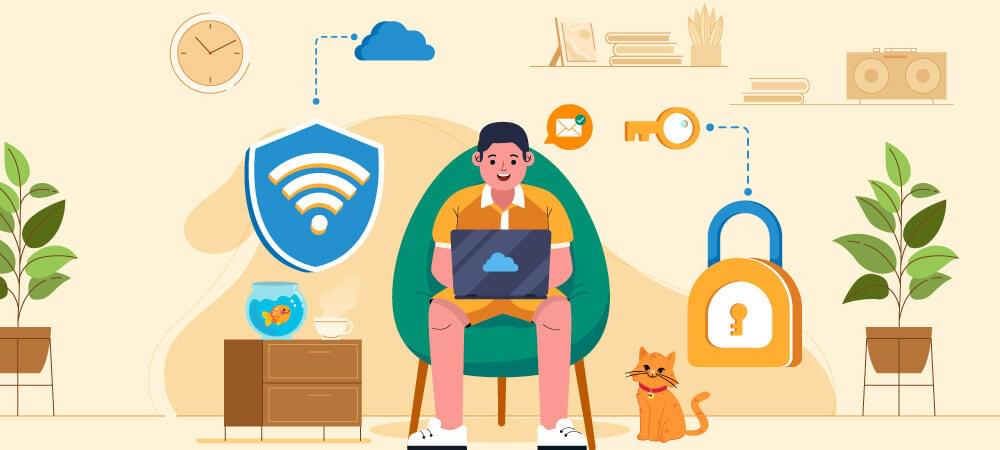How can you secure your home wireless network for teleworking?
In today’s world of remote work culture, securing your home wireless network is one of the most essential aspects. As the bridge to your digital workspace, your home network must be protected from cyber threats. In this detailed step-by-step guide, we will discuss the crucial measures you can take to secure your home network while teleworking, providing you with peace of mind and uninterrupted productivity.
Importance of home network security
These days, with remote work becoming a reality for millions of businesses, the importance of home network security cannot be ignored. Your home network is where you handle confidential work and personal data, making protecting your information from prying eyes vital.
Illegal approaches to your network can result in data hacking and blackmailing, leading to financial and reputational loss. A secure data network also ensures seamless operations and minimizes downtime due to security incidents, allowing you to work efficiently without unnecessary interruptions.
Steps for ensuring network security
Ensuring the security of your home network involves a combination of best practices and the use of advanced security features. By incorporating these steps, you can simply enhance the protection of your network:
Keep router firmware updated
Regularly updating your router’s firmware is a simple yet effective step to patch security leak points. By keeping your router’s software up to date, you can beat known threats and strengthen your network’s defense against cyber attacks. Check your router manufacturer’s website for firmware updates and install them promptly.
Change default passwords
Hackers often target routers with default passwords that are widely known and easily guessable. To make your network less vulnerable, change the default login credentials to strong, unique passwords. Choose passwords at least ten characters long, including numbers, uppercase letters, and lowercase letters with symbols.
Activate WPA3 encryption
Utilize the latest encryption standard, WPA3, for your wireless network. WPA3 offers enhanced protection against potential attacks compared to previous versions. It strengthens the security of your network by using more robust encryption algorithms, making it significantly more impossible for hackers to intercept and decrypt your wifi traffic.
Establish guest networks
Create a separate guest network for your work devices if your router allows it. This isolated network prevents guests from accessing personal data and eliminates the risk of unwarranted access to your leading network. Ensure that the guest network is password-protected and has limited access privileges.
Embrace virtual private networks (VPNs)
A VPN encrypts your internet connection, ensuring your data remains confidential and secure. This is especially important when working on public wifi networks. VPNs create an extra layer of protection against potential eavesdropping and data interception by creating a route for your internet traffic through a secure network.
Consider using a reputable VPN service like EonVPN to secure your internet connection while teleworking.EonVPN, a forever free VPN, provides a secure, fast, and reliable VPN service to protect your work and ensure your activity logs are never recorded.
Employ a firewall network
Most wifi routers have built-in firewall systems that act as a wall between your network and the outside world. Activate this feature to filter incoming and outgoing traffic, shielding your devices from potential threats. Additionally, consider utilizing a software firewall on your devices for an added layer of protection.
Keep updating your device
Regularly updating all your devices, from computers to smartphones, with the latest security patches and software updates is crucial for maintaining a secure network. Old software can contain some weak points that hackers can exploit. Set your devices to update or regularly check for updates manually automatically.
Install antivirus software
Install trusted antivirus software on your devices to add an extra layer of security. Effective antivirus software helps detect and prevent malware invasions and safeguards your network from cyber threats. Update your antivirus software occasionally and run daily scans to identify and eliminate potential threats. If you’re looking for a reliable solution, Cybernews has recognized Bitdefender antivirus software as one of the top solutions for its strong protection and advanced security features.
Enable two-factor authentication (2FA)
Always enable two-factor authentication (2FA) for your router and other devices. This dual-verification process clears your security by adding a form of authentication, such as a code sent to your smartphone and your password. This will add an extra wall of protection against unauthorized access to your network.
Disable remote management
While remote management features in routers can be convenient, they can also be vulnerable to exploitation by cyber attackers. If remote access is unnecessary for your work, turning off this feature is recommended to prevent unauthorized access to your network.
Monitor network traffic
Use network monitoring tools to check the devices connected to your network. Unusual activity may signal a security breach or the presence of unauthorized devices. You can detect and delete potential threats or intrusions by monitoring network traffic.
Use strong passwords everywhere
In addition to your wifi password, ensure that all your accounts and devices have strong, unique passwords. Avoid reusing passwords across different platforms, and consider using a PIN Manager to store and manage your passwords securely.

Additional layers of security
In addition to these steps mentioned above, there are also some additional measures you can use to enhance the security of your home network further:
Safeguard IoT devices
Internet of Things devices (IoT), such as smart home devices, can be easily targeted by cyber attacks. Change the default passwords on these devices to unique, strong passwords and keep their firmware up to date. Also, regularly check for security updates for your IoT devices and follow best practices for securing them.
Secure your workstation
Take steps to secure your workstation, such as using strong passwords or biometric authentication for your computer. Remember to lock your screen when not in use and consider encrypting your hard drive for added security.
These measures help protect sensitive work data in case of physical theft or unauthorized access.
Regularly back up data
Establish a routine for backing up your work data into an external drive or any other secure cloud service. These regular backups ensure that even if your network or devices are compromised, you can restore your data and minimize the impact of a cyber-attack. Always choose a trustworthy backup solution and regularly test your backups to ensure their integrity.
Create awareness in your house
Ensure that everyone in your house understands the significance of network security. Educate them on safe online practices and the importance of following security protocols. By creating awareness about cybersecurity at home, you can reduce potential risks and strengthen the overall security of your network.
Conclusion
Using the steps discussed in this comprehensive guide, you can create a secure home network that safeguards your valuable work data, minimizes disruptions, and ensures only authorized access. Upholding a proactive stance towards network security enables you to enjoy a productive and secure teleworking experience. Remember to choose an authentic VPN service like EonVPN to provide additional protection for your work-related internet activities.

